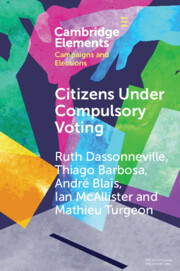Element contents
Citizens Under Compulsory Voting: A Three-Country Study
Published online by Cambridge University Press: 19 September 2023
Summary
- Type
- Element
- Information
- Online ISBN: 9781009071116Publisher: Cambridge University PressPrint publication: 12 October 2023
References
- 1
- Cited by



